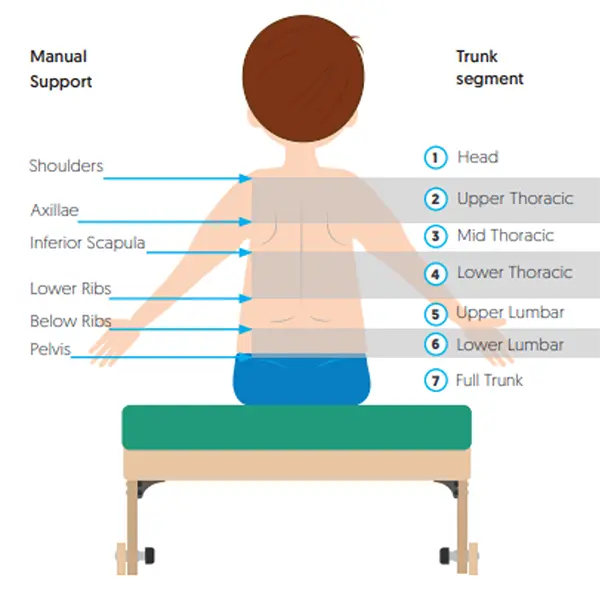Take it offline!
This Education in Motion resource is also available as a printable PDF.
Download PDF
Many strategies for providing postural support to clients are based on facilitating proximal stability for distal function or subjectively assessing their postural control. SATCo is an alternative assessment strategy used to objectively measure where to offer postural supports and where therapy should be focused to improve posture and balance.

SATCo stands for Segmental Assessment of Trunk Control. It involves a structured process of evaluating the level of trunk control starting from the head and moving toward the pelvis, one body segment at a time. Static (no movement), active (reaching), and reactive (with a perturbation from the tester) control is evaluated. The client must have control is all three domains before moving to the next level.
Incorporating SATCo into Assessment
Begin by integrating SATCo into postural assessments and interventions. By utilizing the standardized measures provided by SATCo, clinicians can gather baseline data on clients' control, allowing for a more targeted approach to intervention or even illustrating the before and after effects of a seating intervention.
Tracking Progress Over Time
One of the key benefits of SATCo is its ability to track progress or change over time. Regularly administering assessments allows clinicians to identify changes in postural control. This data-driven approach empowers therapists to make informed decisions about the direction of the treatment or a seating intervention.
Tailoring Interventions
SATCo provides therapists with a nuanced understanding of where a client loses postural control. Armed with this information, therapists can tailor their interventions more effectively. Whether adjusting therapeutic interventions (targeted training) or altering the postural supports in their seating systems, SATCo guides therapists in refining their approach to meet a client's evolving needs.
Demonstrating Effectiveness
In an era where evidence-based practices are highly valued, SATCo offers therapists a means to demonstrate the effectiveness of their interventions. The systematic and data-driven nature of SATCo assessments contributes to building a solid foundation for evidence-based practice.

Integrating SATCo into your clinical approach can be a game-changer for therapists looking to enhance the quality and effectiveness of their interventions. By utilizing SATCo's assessment tools and tracking progress over time, therapists can create a more informed therapeutic process. As assistive technology continues to evolve, tools like SATCo ensure that therapists provide client-centered and evidence-based care. Learn more about SATCo.
References
- Butler PB, Saavedra S, Sofranac M, Jarvis SE, Woollacott MH. Refinement, Reliability, and Validity of the Segmental Assessment of Trunk Control. Pediatric Physical Therapy. 2010; 22(3):246:-257. Winner of the Toby Long Award for the best manuscript published in Paediatric Physical Therapy, 2010.
- Palisano RJ, Rosenbaum P, Walter S, et al. Development and reliability of a system to classify gross motor function in children with cerebral palsy. Dev Med Child Neurol. 1997; 39:214-223. https://canchild.ca/en/resources/44-gross-motor-function-measure-gmfm.
- Haley SM, Coster WJ, Ludlow LH, Haltiwanger JT, Andrellos PA. Pediatric Evaluation of Disability Inventory: Development, Standardization and Administration Manual. Boston, MA: Trustees of Boston University, 1992. Haley S, Coster W. PEDI-CAT: Development, Standardization and Administration Manual. Boston, MA: CRECare, LLC, 2010.
- Pountney TE, Cheek L, Green E, Mulcahy C, Nelham R. Content and Criterion Validation of the Chailey Levels of Ability. Physiotherapy. 1999; 85(8): 410-416.
- Rodby-Bousquet E, Persson-Bunke M, Czuba T. Psychometric evaluation of the Posture and Postural Ability Scale for children with cerebral palsy. Clinical Rehabil. 2016; 30(7):1-8. Rodby-Bousquet E, Agustsson A, Jonsdottir G, Czuba T, Johansson AC and Hagglund G. Interrater reliability and construct validity of the Posture and Postural Ability Scale in adults with cerebral palsy in supine, prone, sitting and standing positions. Clin Rehabil 2014; 28:82-90. (Note: This paper gives the PPAS in full.)